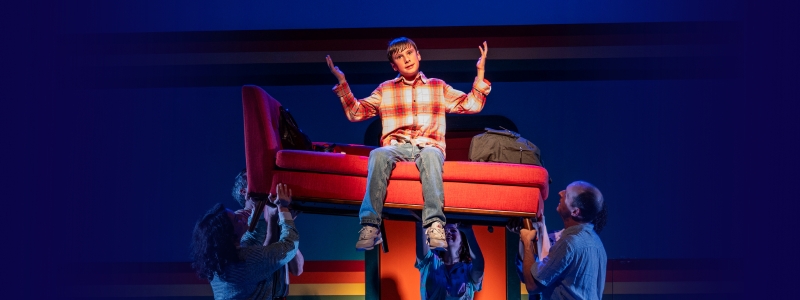Pre-Show Classroom Activity

Invite students to build their very own game board as an avenue to character development! This activity is inspired by the games that are featured in Falsettos.
As always, please note that some steps of the activity may be condensed, eliminated, or extended based on the needs of your classroom.
The Games We Play
Activity Preparation
- Supplies:
- The Games We Play activity slides, for display
- The Games We Play handout (one per student)
- Virtual dice roller (like this one)
- Small objects that can be used as game pieces (i.e. pennies, erasers, or other small objects that fit on the game boards) (may be provided by teacher or students)
- Set-Up:
- Teachers may wish to facilitate game play with the entire class as a whole by conducting the digital dice roll and having all students move the displayed number on their own boards.
- This activity is designed for students to engage in their game board independently, but it would make an excellent activity for partners.
This activity will take approximately 40 minutes.
Learning Sequence
- Distribute copies of the activity handout and display Slides 1 and 2. Explain that students will each be creating a board game, loosely inspired by both Falsettos and The Game of Life. They will use their board games to chart the life events of a character of their choice. (~3 minutes)
- If needed, show students a few Google images of The Game of Life to familiarize themselves with the format and themes of the game. Note, though, that this activity does deviate significantly from that game.
- Prompt students to decide who their character might be and add their name to their The Games We Play handout (Slide 3). Note that some of the life events students add to their boards might be difficult—for this reason, students should be encouraged to invent a character, rather than use themselves. They may choose to invent someone totally original, or use a television, movie, or book character as inspiration. (~2 minutes)
- Display Slides 4 and 5. Point out that almost every square on the game board has a space to write with a prompt below. The prompts direct players to move up or back a number of spaces, or to add or subtract from their next roll. (~1 minute)
- Have students add events to their game boards until every square has one. These events should “match” the prompts in the boxes; for example, a positive event (like earning a promotion or falling in love) might go in squares that prompt the player to move forward. More negative events (like losing a job or going through a breakup) can go in squares that prompt backwards moves. Note, however, that students may assign the same event different values. It’s up to you how you assign those movements’ values! One person might put “get married” on a square that prompts a big jump forward, but another person might see that as a less valuable life event. (~15 minutes)
- Students can write events that they hope to experience; events that their family members or loved ones have gone through; events that are common rites of passage; or anything they like. They may choose to root these events in reality, or to bring in more fantastical elements (i.e. “discover the ability to fly).
- Encourage students to pick events that cover the full range of human experiences, from hardships to happiness.
- Point students to the events on Slide 5. These are all loosely related to the plot of Falsettos. Students may wish to incorporate some, all, or none of these events into their game board.
- Once students have completed their boards, direct them to locate a small object to use as a game piece (Slide 6). Have them pull up a digital dice to play with on their own devices, or project one to to roll for the entire class. (~2 minutes)
- Play the game! Remind students to make a mental note of some of the major life experiences their character has. (~10 minutes)
- Note that students should only follow a prompt immediately after they roll and move. A student should not roll, move, and move again according to the new square they end up in.
- Once students have reached the “end” of their character’s journey, have them flip over their game board to reflect. Students should first write at least five of the most impactful personal life events that their character has had. Then, they should use these experiences to reflect on how life circumstances and personal choices will impact their character’s development, answering the questions on the right-hand side of the handout. (~8 minutes)
- As time allows, invite students to turn and talk or share with the class how their character’s journey influences the person they become.
- This activity aligns with the following standards:
- Illinois Arts Learning Standards
- Anchor Standard 1: Generate and conceptualize artistic ideas and work.
- Anchor Standard 2: Organize and develop artistic ideas and work.
- Anchor Standard 10: Synthesize and relate knowledge and personal experiences to make art.
- Common Core State Standards
- CCSS.ELA.R.1: Read closely to determine what the text says explicitly and to make logical inferences from it; cite specific textual evidence when writing or speaking to support conclusions drawn from the text.
- CCSS.ELA.R.3: Analyze how and why individuals, events, or ideas develop and interact over the course of a text.
- CCSS.ELA.W.3: Write narratives to develop real or imagined experiences or events using effective technique, well-chosen details and well-structured event sequences.
- CCSS.ELA.W.9: Draw evidence from literary or informational texts to support analysis, reflection, and research.
- Illinois Arts Learning Standards